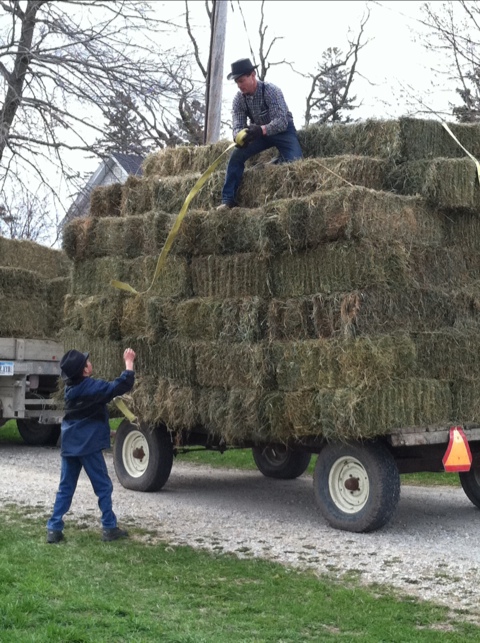It’s hay time people! And it reminds me of sweat, dust up the nose, hay in the hair, and a lot of scratches and sore muscles the day after. But man, does an ice cold beer taste good afterwards. Actually, I don’t know that since the last time I bailed hay was when I was 18. But I do think I will have an ice cold one tomorrow and I will let you know really how good it is.
Yes, making hay is a process and it’s a lot of hard work. And usually the bailing happens on one of the hottest days of the summer. If we can get 4 hay crops in, it would be great. All ruminant animals eat grass or forage material, and during the winter when all the grass is under the snow, these animals have to eat grass or an alfalfa mix to remain healthy, thus, the reason why we make hay and store it in a barn or shed. Our hay ground is mostly located in field waterways and end row areas. Some of it is a mix of seeded alfalfa, which is a very rich plant with a ton of valuable nutrients for horses, cows, goats, and sheep. Maybe llamas too? But grass hay or a mix of grass and alfalfa is a good staple for these animals. In nature, grass is what they live off of. The corn and supplement is only to provide protein to beef lambs up for a higher market value or to provide energy during the cold, winter months.
The video shown here is the pasture behind our house. The mama sheep graze here all summer and fall but we first cut a layer of hay off of it. By cutting it, it actually makes it grow better for the sheep to eat. In turn, they bring nutrients back into the pasture with their poop pellets. Nature can be so convenient and efficient sometimes. You can see that we cut the hay and it needs to dry for a day and raked before we bail it into bales of hay. That process will come in a future post. You’ve already seen the end result in a previous post of the hay auction.
Besides the beautiful and calming sound of frogs in the video, you can hear the far cries of sheep baaaaa-ing. Yesterday was the D-day to ween the lambs from their mothers. I love my job, but seeing and hearing animals suffer, is not part of the job I enjoy and it makes me rethink and weigh the pros and cons of keeping sheep on our farm. The mothers are so connected to their little ones and visa versa, that it is really, really sad to see them separated. They cry all day and into the next and many of them go hoarse. The lambs don’t eat and feel a lot of stress, which is bad on their immune system. I am an animal lover, so I am more sensitive to their suffering and pain I suppose, and both Johnny and I have a conflict within ourselves of raising animals for conventional meat purposes. Bringing the lambs to an auction house is one of the most difficult things to deal with on an emotional level. I don’t eat lamb, but I do eat pork, chicken and fish, so this is why it is an inner conflict. Should I stop eating meat? Should I only eat organic and humanely killed meat to support that process more than the conventional slaughter of animals? But, more on this topic later. I have many thoughts on it that I’d like to share.
To give you an update today, the lambs have been let out to pasture and the ewes have been led out to a different pasture. They do have some contact on one fence line, but are both more concerned about eating than their relationship. This is the weening process. The mother ewes are slowly producing less and less milk and the lambs are slowly becoming more independent. There are a few cries for momma today, but it is slowly diminishing. It still brings tears to my eyes though.

